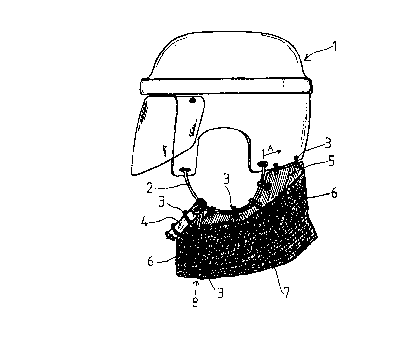Some of the information on this Web page has been provided by external sources. The Government of Canada is not responsible for the accuracy, reliability or currency of the information supplied by external sources. Users wishing to rely upon this information should consult directly with the source of the information. Content provided by external sources is not subject to official languages, privacy and accessibility requirements.
Any discrepancies in the text and image of the Claims and Abstract are due to differing posting times. Text of the Claims and Abstract are posted:
| (12) Patent Application: | (11) CA 2286588 |
|---|---|
| (54) English Title: | A PROTECTOR FOR HOCKEY PLAYER |
| (54) French Title: | DISPOSITIF PROTECTEUR POUR JOUEUR DE HOCKEY |
| Status: | Deemed Abandoned and Beyond the Period of Reinstatement - Pending Response to Notice of Disregarded Communication |
| (51) International Patent Classification (IPC): |
|
|---|---|
| (72) Inventors : |
|
| (73) Owners : |
|
| (71) Applicants : |
|
| (74) Agent: | SMART & BIGGAR LP |
| (74) Associate agent: | |
| (45) Issued: | |
| (86) PCT Filing Date: | 1998-04-16 |
| (87) Open to Public Inspection: | 1998-10-29 |
| Availability of licence: | N/A |
| Dedicated to the Public: | N/A |
| (25) Language of filing: | English |
| Patent Cooperation Treaty (PCT): | Yes |
|---|---|
| (86) PCT Filing Number: | PCT/FI1998/000335 |
| (87) International Publication Number: | WO 1998047575 |
| (85) National Entry: | 1999-10-18 |
| (30) Application Priority Data: | ||||||
|---|---|---|---|---|---|---|
|
A protection for a player on skates, mainly meant to protect the player's
neck, having the quality especially to protect against cuts caused by the
skate blade. The protection is a flexible safety equipment to be fitted around
the neck and having at least one joint (8) which can be opened so that the
protection can be put on the neck and taken off the neck. The protection
comprises fastening means (3) in order to be joined to a helmet (1) and at
least a portion of the protection is to its material of flexible woven fabric.
Dispositif protecteur pour joueur sur des patins, prévu principalement pour protéger le cou, spécialement conçu pour protéger contre les coupures provoquées par les lames de patin. Ledit dispositif est un équipement de sécurité souple qui se place autour du cou et possède au moins une articulation (8) qui peut être ouverte de façon à mettre et à enlever ce dispositif. Il comprend des moyens de fixation (3) destinés à le fixer sur un casque (1) et au moins une partie qui est constituée d'une matière tissée souple.
Note: Claims are shown in the official language in which they were submitted.
Note: Descriptions are shown in the official language in which they were submitted.

2024-08-01:As part of the Next Generation Patents (NGP) transition, the Canadian Patents Database (CPD) now contains a more detailed Event History, which replicates the Event Log of our new back-office solution.
Please note that "Inactive:" events refers to events no longer in use in our new back-office solution.
For a clearer understanding of the status of the application/patent presented on this page, the site Disclaimer , as well as the definitions for Patent , Event History , Maintenance Fee and Payment History should be consulted.
| Description | Date |
|---|---|
| Inactive: IPC from MCD | 2006-03-12 |
| Inactive: IPC from MCD | 2006-03-12 |
| Time Limit for Reversal Expired | 2004-04-16 |
| Application Not Reinstated by Deadline | 2004-04-16 |
| Deemed Abandoned - Failure to Respond to Maintenance Fee Notice | 2003-04-16 |
| Inactive: Abandon-RFE+Late fee unpaid-Correspondence sent | 2003-04-16 |
| Inactive: Cover page published | 1999-12-02 |
| Inactive: First IPC assigned | 1999-11-29 |
| Inactive: Notice - National entry - No RFE | 1999-11-17 |
| Application Received - PCT | 1999-11-12 |
| Application Published (Open to Public Inspection) | 1998-10-29 |
| Abandonment Date | Reason | Reinstatement Date |
|---|---|---|
| 2003-04-16 |
The last payment was received on 2002-04-15
Note : If the full payment has not been received on or before the date indicated, a further fee may be required which may be one of the following
Please refer to the CIPO Patent Fees web page to see all current fee amounts.
| Fee Type | Anniversary Year | Due Date | Paid Date |
|---|---|---|---|
| MF (application, 2nd anniv.) - small | 02 | 2000-04-17 | 1999-10-18 |
| Basic national fee - small | 1999-10-18 | ||
| MF (application, 3rd anniv.) - small | 03 | 2001-04-17 | 2001-04-09 |
| MF (application, 4th anniv.) - small | 04 | 2002-04-16 | 2002-04-15 |
Note: Records showing the ownership history in alphabetical order.
| Current Owners on Record |
|---|
| KARI ARTO OLAVI VIITALAHTI |
| Past Owners on Record |
|---|
| None |